Page content
"With All the Grace of the Sex"
Text by Donna Dene Woodward
Photos by Dave Doody
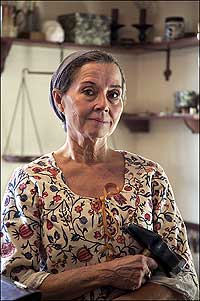
Paul Revere's mother likely was a silversmith before her son. Gayle Clark has wielded a hammer at Colonial Williamsburg's Golden Ball silversmith's shop for twenty-five years.
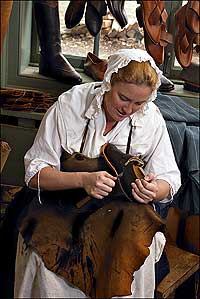
Author Donna Woodward worked for many years in Colonial Williamsburg's Shoemaker's Shop, one of many trades in which women participated during the eighteenth century.
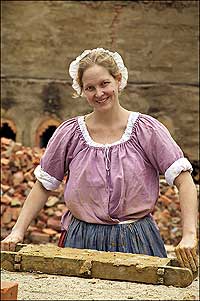
At Colonial Williamsburg's Brickmaker's Yard, Christine Trowbridge uses a double form to shape bricks to be fired for Historic Area use, broken bricks and a kiln behind her.
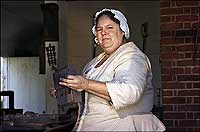
Suzanne Dye works amid the flames and the fumes in Colonial Williamsburg's Geddy Foundry. Some colonial women were metalworkers.
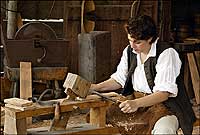
In Colonial Williamsburg's Cooper's Shop, Ramona Vogel shapes staves for a cask. Few trades were without women at some point.
Traveling through the English countryside in 1741, William Hutton happened upon a blacksmith's shop, where he saw "one or more females, stripped of their upper garments, and not overcharged with the lower, wielding the hammer with all the grace of the sex." If Hutton was taken aback, it might not have been so much by the costuming as by finding women working a trade usually practiced by men.
Journeyman Gayle Clarke is working in the James Craig silversmith shop on a typical July day in Colonial Williamsburg. Her sleeves are rolled, she's sweating, and she's swinging a forging hammer over a thick piece of silver. In spite of the Tidewater humidity, there's a fire blazing in the fireplace so Clarke can anneal the ingot when it's hardened. Guests mill about the shop. A woman looks around, walks into the back, peers down the hall, turns to her companions and says, "Oh, I guess none of the silversmiths are working today."
Clarke laughs as she recounts the story, variations of which have happened many times over her nearly twenty-five- year career. "I don't get much of an opportunity to talk to those folks," she says. "They've got their minds made up about women's roles. But the guests that ask where my husband is, or why am I working, those are the guests that are fascinated to find out about the historical accuracy of my presence."
An apprentice female at the Anderson Blacksmith Forge in the late 1980s drew attention from guests. Journeyman supervisor Ken Schwarz and his colleagues were often asked whether women were allowed to be blacksmiths. "It's as if there were some law forbidding women from work, or the ever-present worry that this work was too physically demanding for women to carry out," Schwarz says.
Guests expect to see women cooking, cleaning, sewing, and raising and educating children in the home, and are understandably perplexed by a female swinging a hammer at a forge or planing a board at the cooper's. This curiosity often leads to questions of political correctness versus historical accuracy. Answering such questions is not easy. It requires a detective's nose for documentation and sometimes lucky happenstance.
The Historic Area's modern apprenticeship system is modeled on eighteenth-century practices. Men and women admitted to the program are expected to learn their trade and become journeymen, a representation of the day-to-day reality of eighteenth-century life. The master of her shop has carefully documented Clarke's progress, and a twenty-fifth-century historian will be able to understand her role in the business. But what of those partially clad Englishwomen working as blacksmiths? How did they get there?
Other than Hutton's remark, there's nothing suggesting their names or family situations. For most girls, becoming a blacksmith was probably not a dream. Husband, family, home: those were the pursuits of a young woman of the eighteenth century. Finding a woman or women working at all outside the home, much less in a male-dominated trade, most likely meant the dream wasn't shaping up the way they'd hoped. Some women worked because they had no choice.
Though there was no system of standards governing the trades in the colonies, the method of learning a trade generally followed the apprenticeship guidelines established by the guilds in medieval England and Europe. Women were not excluded from membership in any of the earlier guilds. The Worshipful Company of Blacksmiths in London lists sixty-five "brethren" and two "sistren" in its 1434 charter.
"No one contested the right of wives and daughters to work in a shop or at a stall leased in the name of the husband and father," writes Olwen Hufton in The Prospect before Her: A History of Women in Western Europe, 1500-1800. "The tendency of a master in an occupation where there was scope for the employment of his daughter—particularly if he had no sons—may have been to familiarize her with the techniques of the trade. At the humblest levels, where the master in question did not employ journeymen and where any apprentices kept quiet, then the master's daughter unofficially may have done much work without incurring opposition from the guild."
Blacksmith Schwarz says it is important to consider the woman's role in a family business: "It is just that—a family working to produce an income. In periods of sharp increase in demand, any able-bodied member of the family may be involved in making the business successful. Including women."
Male or female, a prospective guild member had to apply for entrance by apprenticeship, patrimony, redemption, or marriage. Most women applied by right of marriage, or widowhood. More than 200 youngsters are documented to have been apprenticed to women in Oxford between 1520 and 1800, evidence that women claimed the rights of masters.
Conspicuous differences existed in the strength and types of guilds to enforce their control and keep work from slipping under women, so a female's success or participation in a business could vary from place to place, from year to year. "Complaints were more common in periods of economic strain," Hufton wrote, "particularly when the labour supply was overabundant and rising prices outstripped wages. In easy times, journeymen were less anxious and might permit without complaint some infiltration by women into what they saw as their sphere of activity."
Girls were apprenticed, too, usually in cases of orphaning. Parish or pauper apprenticeships, as they were called, featured contracts that left blank spaces so the court or church official could write in "him" or "her," "she" or "he." K. D. M. Snell's Annals of the Labouring Poor lists nearly 300 orphan girls apprenticed to trades in the eighteenth century in the southern counties of England.
But the guild system began to decline during the eighteenth century, and with it went the detailed records. A 1770 publication called The Tradesman's True Guide or a Universal Directory for the Towns of Birmingham, Wolverhampton, Walsal, Dudley and the manufacturing village in the neighborhood of Birmingham carries exhaustive lists of tradesmen and -women alphabetically by name and by trade. There are women listed in every trade from butcher to wire drawer. Unfortunately, these rosters only carry the name and address of the individual's business. There is no hint of how he or she came to learn the trade. Records of guilds and corporations frequently omit mention of female apprentices suggests Bridget Hill in Women, Work, and Sexual Politics in Eighteenth-Century England, because "the completion of a man's apprenticeship had political and social, as well as economic consequences (parliamentary franchise) that did not apply to women."
Though apprenticeship contracts do exist for the colonies, they tend to be fewer and they are not as specific. And without the meticulous record keeping of the guilds, what happened to a boy or girl once an apprenticeship began is difficult to track. Orphan apprenticeship contracts are the best research tools, since they often record more detail than a standard agreement, although many of the girls' apprenticed trades are listed as "unspecified," and the only way to surmise what they learned is if the master's or mistress's business is known.
In 1715 Northumberland County, Virginia, Ariskam Crowder was "hereby bound an apprentice to serve Mary Knight in all lawfull Services & imploym until he shall attain the age of One and twenty years, he being Seven year old."
The colonies are full of widows running businesses. A cursory visit to the restored colonial capital will introduce guests to many taverns run by women, and to Clementina Rind, the Virginia Gazette printer who published Thomas Jefferson's Summary View of the Rights of British America in 1774. She took over the business when her husband died. Between the seventeenth and early nineteenth centuries, there are records of at least twenty-one widows running their late husbands' printing businesses. Mrs. Jose Glover set up shop at Harvard, Massachusetts, in 1638 after her husband died on a ship from England. Sarah Goddard ran the Providence Gazette in Rhode Island, learning the business from her brother. Elizabeth Bushell learned from her father, and ran The Halifax Gazette in Canada, from 1752 until 1761. Jane Aitken's father left her his Philadelphia printing business in 1796, favoring her over her brother, who was apparently an "idler tippler and little better than a vagrant, cut off without a sixpence."
Finding women in the smith trades or any of the physically intensive occupations is difficult. A 1730 Pennsylvania Gazette runaway ad searches for James Curry, "an Apprentice to Mrs. Paris of Philadelphia, Brass Founder." An account book at the Litchfield Historical Society shows Mary Stoddard signing all transactions for her dead husband's Connecticut blacksmith business in the 1770s.
There is debate about whether the women who acquired businesses from family did the physical tasks, and whether the girls that were apprenticed to tradesmen ever really learned the trade. Prints seem to suggest some did. Only recently did a Colonial Williamsburg interpreter look closely at a nineteenth-century print that had been hanging on the wall at the Geddy House for years: a portion of Ben Franklin's Poor Richard Illustrated features a country blacksmith shop where four men are working, and in the right-hand corner, a woman hammers at an anvil rather inconspicuously. A 1505 Polish print is centered on a lovely woman at a spindle, but a careful inspection of the background shows a woman making a shoe on her knee.
The written documentation is sometimes not as obvious as an apprenticeship contract, and it takes meticulous readings to find names or hints of working females. There are curious newspaper items, such as one from the Pennsylvania Gazette, dated 1774, in which Joel Willis, the jailer in Chester, Pennsylvania, announced that "John Humphreys and Elizabeth, his wife; both Irish, and shoemakers by trade" were in his custody. Why list man and wife as shoemakers if she didn't make shoes? The Pennsylvania Gazette printed the rules of contracting apprentices to "the Masters or Mistresses" in 1763, such that the youngster "shall be bound by Indenture to serve as an Apprentice in any Art, Mystery, Occupation or Labour, with the Assent of his or her Parent."
Modern visitors wonder how these workingwomen were regarded by their betters and their peers. "Williamsburg was a small town," says Mary Wiseman, who has studied and portrayed Martha Washington, "and this was a time in the world where you were known for your excellence of character and for your ability, and respected for that on a level that personalized the world of the eighteenth century." Abigail Schumann, who has portrayed Clementina Rind for Colonial Williamsburg for almost ten years, believes "the fact that Rind was awarded the government contact in her own right indicates that she was not only accepted, but respected for the work she was doing."
Though creative research has produced evidence of women working at male-dominated occupations in the eighteenth century and before, there is undoubtedly more documentation out there, in newspapers, diaries, legal proceedings, and prints. What is more compelling is the lack of documentation that women were not allowed to work. Although religious practices and social norms might have restricted certain activities in some parts of the world, there were no laws prohibiting women from working a trade.
Yet sometimes scholars and guests have a hard time accepting the notion that women did just that. Schumann says that "the greatest obstacle for the visitor is in accepting Rind as an eighteenth-century woman, and not a 'born-before-her-time' women's libber. She was in debt and had four young children. Fortunately, she was well suited to the task." A modern woman might choose to be a mechanic as an occupation, but an eighteenth-century woman might have had to pick up a hammer or work a press to make ends meet. Perhaps the notion of "choice" is where women's roles have changed in the workforce, but no matter what century it is, women have always done what is necessary to provide for themselves and their families.
Read the transcript.
Freelance writer Donna Dene Woodward was once a member of Colonial Williamsburg's boot and shoemaker's staff. This is her first contribution to the magazine.
For further reading:
